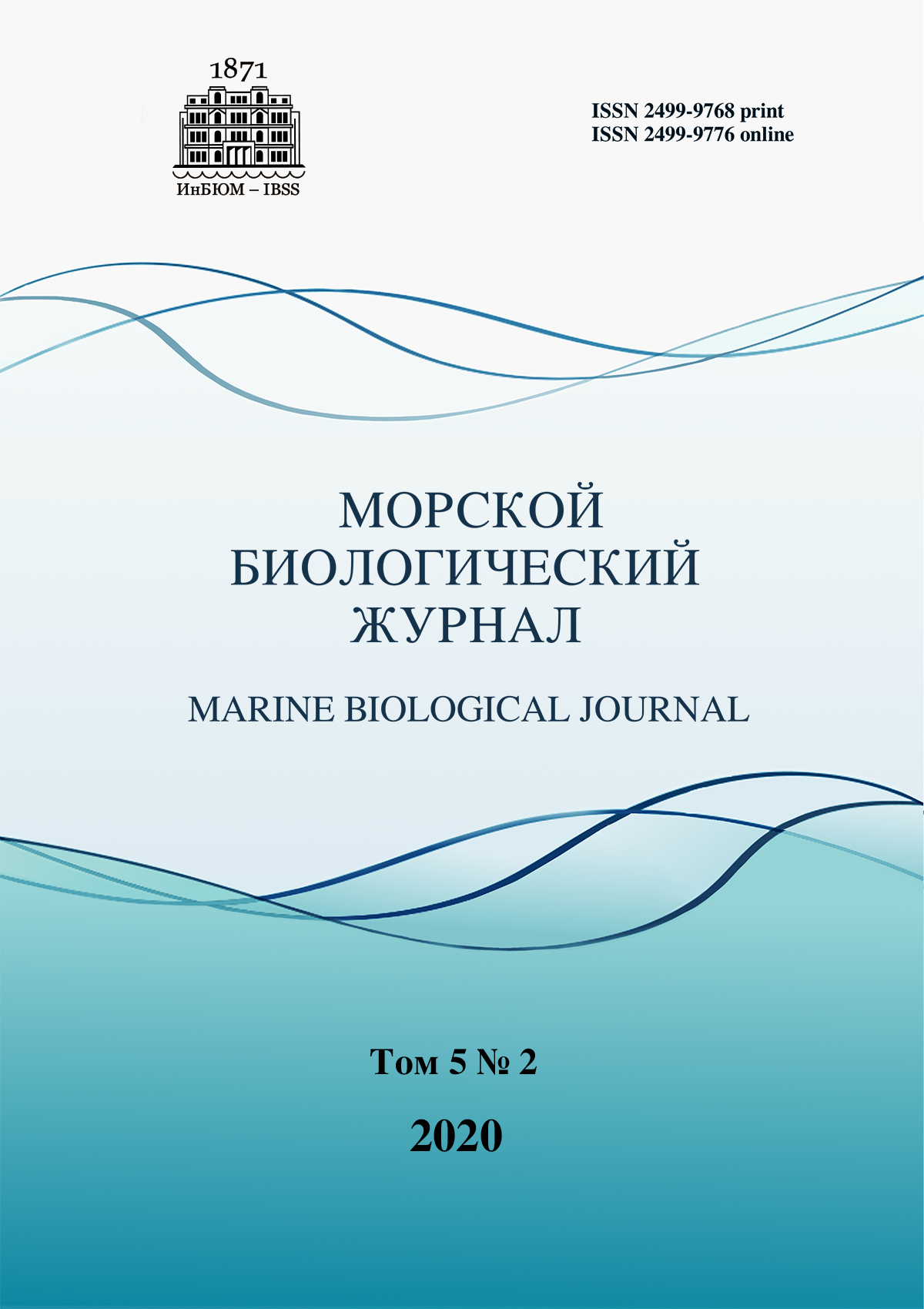Production characteristics of the copepods Arctodiaptomus salinus and Calanipeda aquaedulcis fed with a mixture of microalgae Dinophyceae and Prymnesiophyceae
##plugins.themes.ibsscustom.article.main##
##plugins.themes.ibsscustom.article.details##
Abstract
The ubiquitous copepod species Arctodiaptomus salinus (Daday, 1885) and Calanipeda aquaedulcis (Krichagin, 1873) are important components of food chains of numerous fresh- and saltwater areas. These copepods are suitable for feeding larvae of both marine and freshwater fish species; however, influence of nutrition on the production characteristics of these species is not well understood. Previously we determined that monocultures of microalgae Dinophyceae and Prymnesiophyceae are optimal feeding objects for egg production by females of A. salinus and C. aquaedulcis, survival rate, and development time of these copepods throughout ontogenesis. The aim of this work was to determine the production characteristics of copepods A. salinus and C. aquaedulcis under optimal temperature conditions depending on the model of the feeding with a mixture of microalgae Dinophyceae and Prymnesiophyceae. The highest survival rates of A. salinus from the naupliar stage to the adult one (93–95 %) were observed when copepods were fed with a monoculture of microalga Isochrysis galbana (Parke, 1949) or a mixture I. galbana + Prorocentrum cordatum (Ostenfeld) J. D. Dodge, 1975; the shortest development time (19 days) – when copepods were fed with a mixture of three microalgae I. galbana + P. cordatum + Prorocentrum micans (Ehrenberg, 1834). The shortest development time of C. aquaedulcis from the naupliar stage to the adult one (13 days) was observed when copepods were fed with a mixture of microalgae I. galbana + P. cordatum. The shortest duration of the naupliar stage of development of both copepod species was observed when their diet included I. galbana as a monoculture or one of mixture components. During the copepodit stage, the pattern remains the same, only with P. cordatum. The maximum absolute fecundity of C. aquaedulcis reached 24 eggs per female (I. galbana), of A. salinus – 16 eggs per female (P. cordatum). Egg hatching of C. aquaedulcis when being fed with both monocultures of microalgae P. cordatum and I. galbana and with their mixture reached 100 %. The highest egg hatching rate for A. salinus was reached only when copepod females were fed with a mixture of microalgae I. galbana + P. micans.
Authors
References
Аганесова Л. О. Выживаемость и длительность развития копепод Calanipeda aquaedulcis и Arctodiaptomus salinus в зависимости от питания микроводорослями разных таксономических групп // Морской экологический журнал. 2011. Т. 10, № 2. С. 27–33. [Aganesova L. O. Survival and development times of the copepods Calanipeda aquaedulcis and Arctodiaptomus salinus depending on feeding microalgae of different taxonomic groups. Morskoj ekologicheskij zhurnal, 2011, vol. 10, iss. 2, pp. 27–33. (in Russ.)]
Аганесова Л. О. Длительность развития копепод Calanipeda aquaedulcis и Arctodiaptomus salinus при разном температурном режиме культивирования // Морской экологический журнал. 2013. Т. 12, № 1. С. 19–25. [Aganesova L. O. Development times of the copepods Calanipeda aquaedulcis and Arctodiaptomus salinus at different temperatures. Morskoj ekologicheskij zhurnal, 2013, vol. 12, no. 1, pp. 19–25. (in Russ.)]
Аганесова Л. О. Репродуктивные характеристики самок копепод Calanipeda aquaedulcis и Arctodiaptomus salinus при питании микроводорослями разных таксономических групп // Морской экологический журнал. 2011. Отд. вып. № 2. С. 7–10. [Aganesova L. O. Reproductive characteristics of females of the copepods Calanipeda aquaedulcis and Arctodiaptomus salinus fed microalgae from different taxonomic groups. Morskoj ekologicheskij zhurnal, 2011, spec. iss. no. 2, pp. 7–10. (in Russ.)]
Губарева Е. С., Светличный Л. С. Солёностная толерантность копепод Calanipeda aquaedulcis и Arctodiaptomus salinus (Calanoida, Copepoda) // Морской экологический журнал. 2011. Т. 10, № 4. С. 32–39. [Hubareva E. S., Svetlichny L. S. Salinity tolerance of copepods Calanipeda aquaedulcis and Arctodiaptomus salinus (Calanoida, Copepoda). Morskoj ekologicheskij zhurnal, 2011, vol. 10, iss. 4, pp. 32–39. (in Russ.)]
Ханайченко А. Н. Влияние микроводорослевой диеты на характеристики воспроизводства копепод // Экология моря. 1999. Вып. 49. С. 56–61. [Khanaychenko A. N. The effect of microalgal diet on copepod reproduction parameters. Ekologiya morya, 1999, iss. 49, pp. 56–61. (in Russ.)]
Corkett C. J., McLaren I. A., Sevighy J.-M. The rearing of the marine calanoid copepods Calanus finmarchicus (Gunnerus), C. glacialis Jaschnov, and C. hyperboreus Kroyer with comment on the equiproportional rule. Sillogeus, 1986, vol. 58, pp. 539–546.
Coutteau P. Micro-Algae. Manual on the Production and Use of Live Food for Aquaculture / P. Lavens, P. Sorgeloos (Eds). Rome : FAO, 1996, 300 p. (FAO Fisheries Technical Paper ; no. 361).
Irigoien X., Obermuller B., Head R. N., Harris R. P., Rey C., Hansen B. W., Hygum B. H., Heath M. R., Durbin E. G. The effect of food on the determination of sex ratio in Calanus spp.: Evidence from experimental studies and field data. ICES Journal of Marine Science, 2000, vol. 57, iss. 6, pp. 1752–1763. https://doi.org/10.1006/jmsc.2000.0960
Lacoste A., Poulet S. A., Cueff A., Kattner G., Ianora A., Laabir M. New evidence of the copepod maternal food effects on reproduction. Journal of Experimental Marine Biology and Ecology, 2001, vol. 259, iss. 1, pp. 85–107. https://doi.org/10.1016/S0022-0981(01)00224-6
Payne M. F., Rippengale R. J. Evaluation of diets for culture of the calanoid copepod Gladioferens imparipes. Aquaculture, 2000, vol. 187, iss. 1, pp. 85–96. https://doi.org/10.1016/S0044-8486(99)00391-9
Sapir Y., Mazer S. J., Holzapfel C. Sex ratio. Jorgensen Encyclopedia of Ecology, 2008, vol. 4, pp. 3243–3248. https://doi.org/10.1016/B978-008045405-4.00658-3
Zhukova N. V., Aizdaicher N. A. Fatty acid composition of 15 species of marine microalgae. Phytochemistry, 1995, vol. 39, iss. 2, pp. 351–356. https://doi.org/10.1016/0031-9422(94)00913-E
Zupo V. Influence of diet on sex differentiation of Hippolyte inermis Leach (Decapoda: Natantia) in the field. Hydrobiologia, 2001, vol. 449, iss. 1–3, pp. 131–140. https://doi.org/10.1007/978-94-017-0645-2_13


 Google Scholar
Google Scholar



